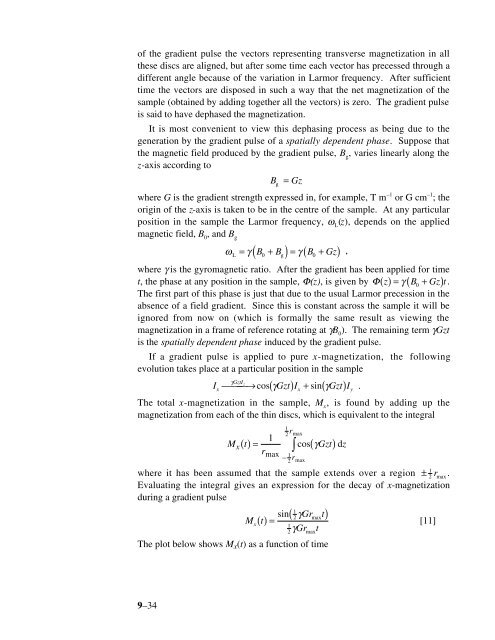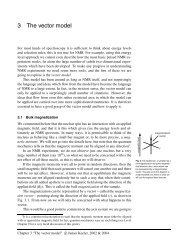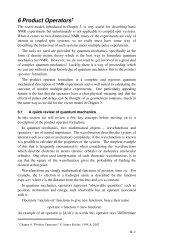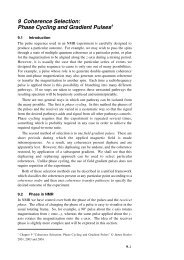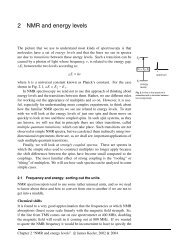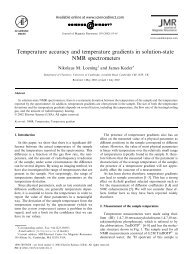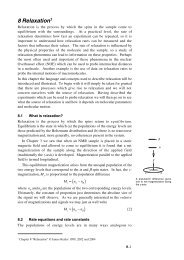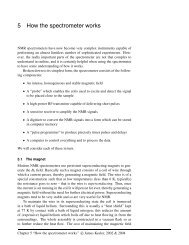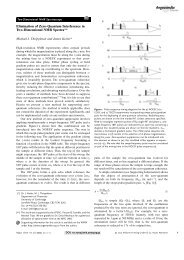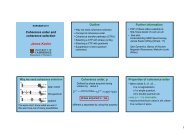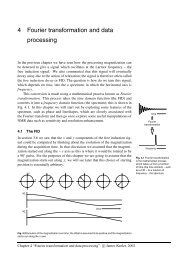Phase Cycling and Gradient Pulses - The James Keeler Group
Phase Cycling and Gradient Pulses - The James Keeler Group
Phase Cycling and Gradient Pulses - The James Keeler Group
You also want an ePaper? Increase the reach of your titles
YUMPU automatically turns print PDFs into web optimized ePapers that Google loves.
of the gradient pulse the vectors representing transverse magnetization in all<br />
these discs are aligned, but after some time each vector has precessed through a<br />
different angle because of the variation in Larmor frequency. After sufficient<br />
time the vectors are disposed in such a way that the net magnetization of the<br />
sample (obtained by adding together all the vectors) is zero. <strong>The</strong> gradient pulse<br />
is said to have dephased the magnetization.<br />
It is most convenient to view this dephasing process as being due to the<br />
generation by the gradient pulse of a spatially dependent phase. Suppose that<br />
the magnetic field produced by the gradient pulse, B g<br />
, varies linearly along the<br />
z-axis according to<br />
B Gz<br />
g =<br />
where G is the gradient strength expressed in, for example, T m –1 or G cm –1 ; the<br />
origin of the z-axis is taken to be in the centre of the sample. At any particular<br />
position in the sample the Larmor frequency, ω L<br />
(z), depends on the applied<br />
magnetic field, B 0<br />
, <strong>and</strong> B g<br />
ωL = γ( B0 + Bg)= γ( B0<br />
+ Gz ) ,<br />
where γ is the gyromagnetic ratio. After the gradient has been applied for time<br />
t, the phase at any position in the sample, Φ(z), is given by Φ()= z γ ( B0 + Gz)<br />
t .<br />
<strong>The</strong> first part of this phase is just that due to the usual Larmor precession in the<br />
absence of a field gradient. Since this is constant across the sample it will be<br />
ignored from now on (which is formally the same result as viewing the<br />
magnetization in a frame of reference rotating at γB 0<br />
). <strong>The</strong> remaining term γGzt<br />
is the spatially dependent phase induced by the gradient pulse.<br />
If a gradient pulse is applied to pure x-magnetization, the following<br />
evolution takes place at a particular position in the sample<br />
γGztIz<br />
I ⎯ →cos γGzt I sin γGzt I .<br />
x<br />
⎯⎯ ( ) + ( )<br />
<strong>The</strong> total x-magnetization in the sample, M x<br />
, is found by adding up the<br />
magnetization from each of the thin discs, which is equivalent to the integral<br />
M x ()= t<br />
1<br />
r max<br />
x<br />
1<br />
2 r max<br />
∫<br />
– 1 2 r max<br />
cos( γGzt)dz<br />
where it has been assumed that the sample extends over a region ± 1 2<br />
r max<br />
.<br />
Evaluating the integral gives an expression for the decay of x-magnetization<br />
during a gradient pulse<br />
( )<br />
sin Gr t<br />
Mx( 1 2<br />
γ<br />
max<br />
t)=<br />
1<br />
2<br />
γGrmaxt<br />
<strong>The</strong> plot below shows M x (t) as a function of time<br />
y<br />
[11]<br />
9–34


